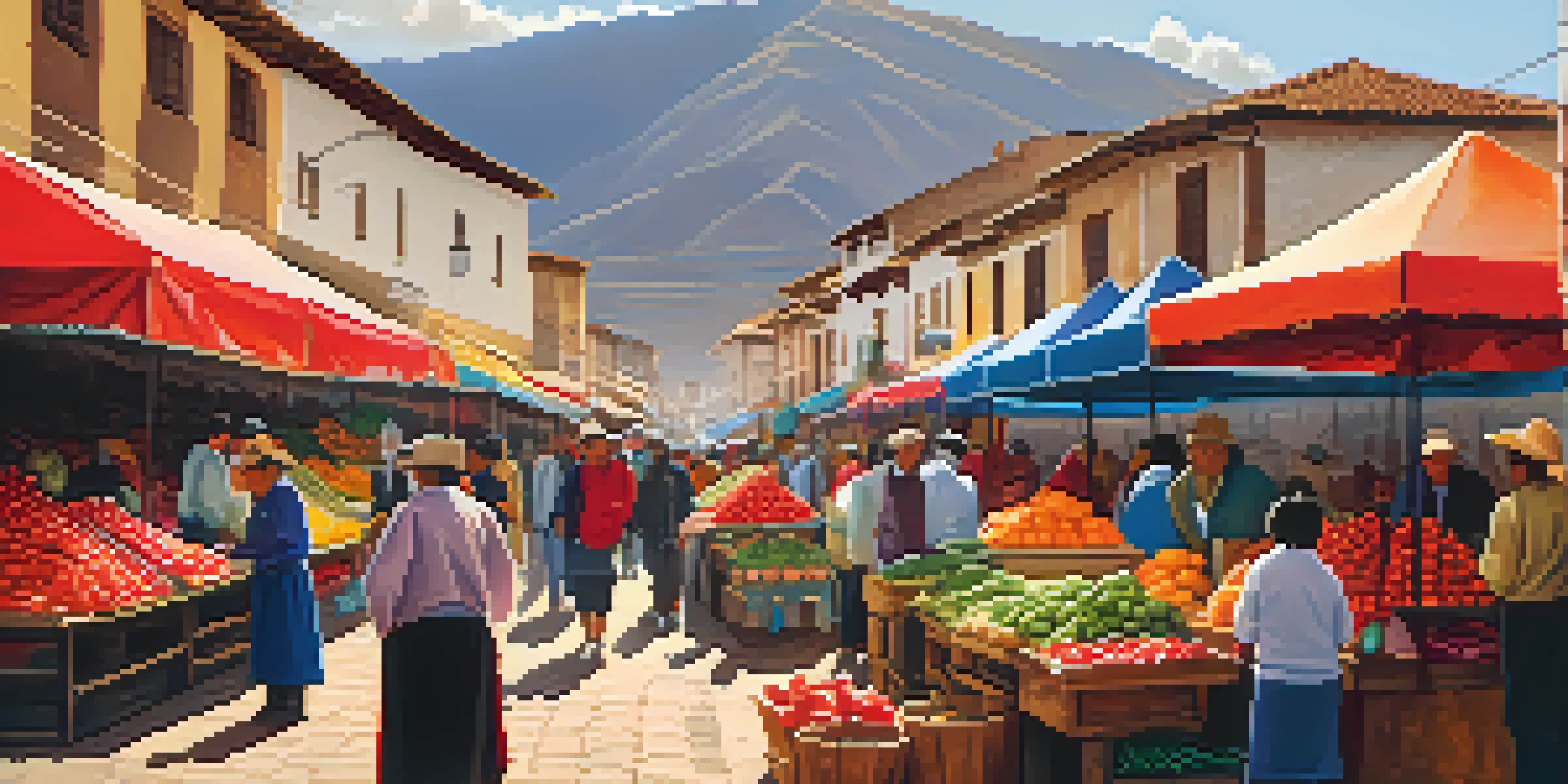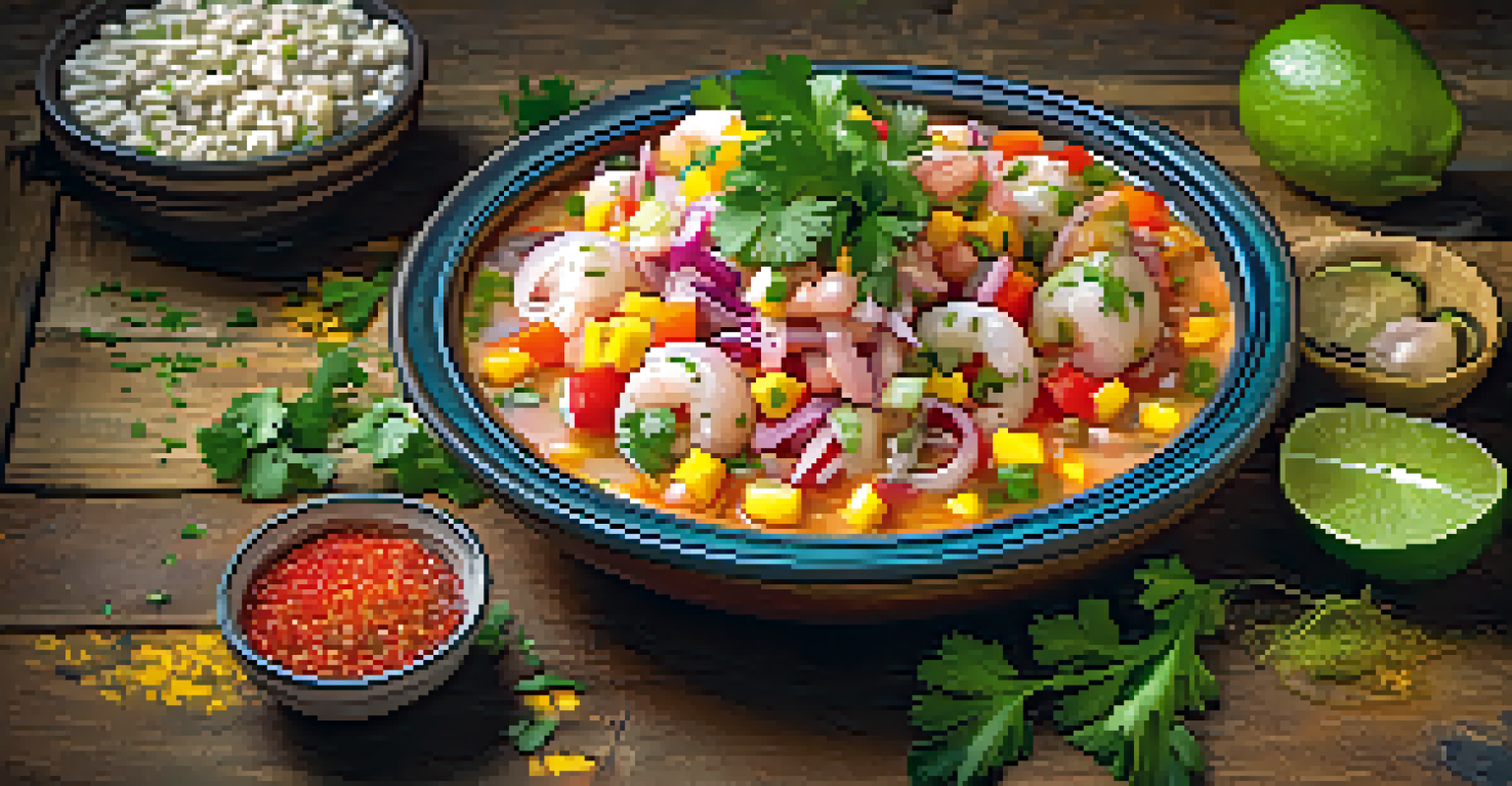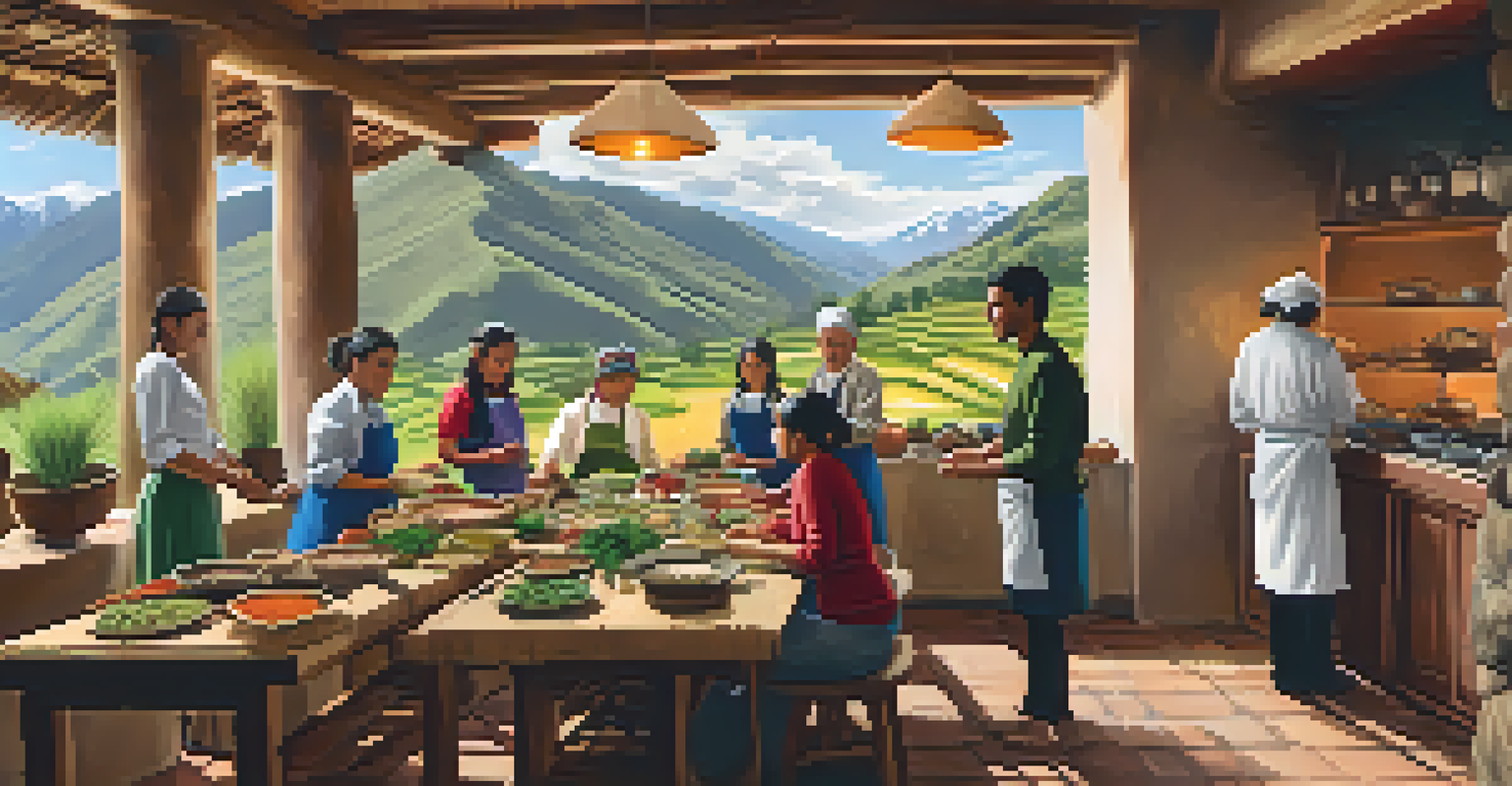The Role of Local Cuisine in Peru's Sustainable Travel Scene

Understanding Peru's Rich Culinary Heritage
Peru is a treasure trove of culinary diversity, deeply rooted in its history and geography. The fusion of indigenous ingredients with influences from Spanish, African, and Asian cuisines has created a vibrant food scene. This rich culinary heritage not only showcases Peru's culture but also tells the story of its people and their traditions. By savoring local dishes, travelers can connect with Peru's past while enjoying its present flavors.
Food is not just what we eat, it is a reflection of who we are and where we are from.
Dishes like ceviche, a fresh seafood delicacy marinated in citrus, highlight the country's coastal bounty. Meanwhile, Andean staples like quinoa and potatoes reflect the agricultural wealth of the highlands. Each region boasts unique flavors, making every meal an opportunity to explore Peru's diverse landscapes. This connection between food and place enhances the travel experience, encouraging visitors to appreciate Peru's natural resources.
Moreover, understanding Peru's culinary roots can foster a deeper respect for the environment. As travelers indulge in local cuisine, they learn about sustainable practices that protect the land and promote biodiversity. This awareness encourages visitors to support local farmers and artisans, creating a positive impact that extends beyond their trip.
Supporting Local Economies Through Food Tourism
Food tourism is a powerful way to support local economies, especially in Peru. By choosing to dine at local markets, family-run restaurants, and street vendors, travelers directly contribute to the livelihoods of local chefs and farmers. This not only creates jobs but also helps preserve traditional cooking methods and recipes that might otherwise be lost. Every meal becomes a way to invest in the community and celebrate its culture.

For instance, markets like Mercado de San Pedro in Cusco offer an array of local ingredients and dishes, allowing visitors to taste authentic Peruvian flavors while interacting with local vendors. Such experiences foster a sense of community and connection, as travelers hear the stories behind the food they enjoy. This engagement enriches their travel experience, turning a simple meal into a memorable cultural exchange.
Culinary Heritage Reflects Culture
Peru's diverse culinary scene showcases its rich history and local traditions through indigenous ingredients and regional dishes.
By prioritizing local dining experiences, travelers also promote sustainable practices within the food industry. Many local chefs emphasize seasonal ingredients and eco-friendly sourcing, minimizing their environmental impact. Choosing to eat local not only enhances the travel experience but also aligns with sustainable travel principles, making it a win-win for both visitors and locals.
The Role of Indigenous Ingredients in Sustainable Cooking
Indigenous ingredients play a pivotal role in Peru's culinary landscape, contributing to both flavor and sustainability. Ingredients like aji peppers, native potatoes, and various grains are not only delicious but also have lower environmental impacts compared to imported foods. By embracing these local ingredients, chefs can create dishes that celebrate Peru's biodiversity while promoting sustainable agricultural practices.
To be a chef is to be a steward of the land, a guardian of the culture, and a storyteller of the ingredients.
For example, the use of native potatoes, which come in thousands of varieties, showcases the importance of preserving local crops. Sustainable farming methods employed by local farmers ensure that these ingredients are grown without the heavy use of chemicals, benefiting both the land and the health of consumers. This emphasis on indigenous ingredients not only supports local agriculture but also educates travelers about the importance of biodiversity in food systems.
Furthermore, dishes made with indigenous ingredients often have cultural significance, connecting travelers to the traditions of Peru's indigenous communities. By enjoying these meals, visitors gain insight into the values and practices that sustain these communities. This connection between food and culture enhances the overall travel experience, making it both enjoyable and enlightening.
Culinary Experiences That Promote Conservation
Engaging in culinary experiences can promote conservation efforts in Peru, making travel more meaningful. Cooking classes and food tours often incorporate lessons on sustainable practices, encouraging participants to consider the environmental impact of their food choices. By learning how to prepare traditional dishes, travelers gain a deeper appreciation for local ingredients and the ecosystems that support them.
For instance, a cooking class in the Sacred Valley might include a visit to a local farm, where travelers can see firsthand how ingredients are cultivated sustainably. This immersive experience not only enhances their understanding of Peru’s food culture but also fosters a sense of responsibility toward environmental conservation. By connecting food preparation with sustainable practices, participants are inspired to adopt similar habits at home.
Food Tourism Boosts Local Economies
Choosing local dining experiences allows travelers to support local chefs and farmers, contributing to community development and cultural preservation.
Moreover, these culinary experiences often contribute to local conservation initiatives. Some programs donate a portion of their proceeds to environmental projects, reinforcing the connection between local food, culture, and conservation. This model not only supports sustainable tourism but also ensures that the natural beauty of Peru is preserved for future generations to enjoy.
Promoting Cultural Exchange Through Food
Food serves as a universal language, promoting cultural exchange between travelers and locals. When visitors share a meal with locals, they engage in a dialogue that transcends language barriers, fostering understanding and respect. This exchange allows travelers to appreciate the nuances of Peruvian culture, from culinary techniques to traditional dining customs.
For example, participating in a traditional Peruvian feast, known as a pachamanca, offers a unique insight into the cultural significance of food in celebrations. Guests can experience the communal aspect of cooking and dining, where food is not just sustenance but a way to bring people together. Such experiences enrich the travel journey, creating lasting memories and connections.
Additionally, as travelers share their own culinary traditions, the exchange becomes mutually beneficial. Locals can learn about different cultures while showcasing their own, creating a vibrant tapestry of shared experiences. This cultural exchange through food fosters a sense of global community, reminding us of our shared humanity.
Sustainable Dining Practices in Peru
Sustainable dining practices are gaining traction in Peru, as more restaurants prioritize eco-friendly approaches. Many chefs are committed to sourcing ingredients locally, reducing their carbon footprint while supporting local farmers. This trend not only enhances the quality of the food but also strengthens the bond between the culinary community and the environment.
Restaurants like Central in Lima focus on seasonal menus that celebrate the diversity of Peruvian ingredients. By highlighting local produce, they contribute to the sustainability of the food system while offering diners a taste of the country’s rich biodiversity. This commitment to sustainability is not just a trend; it's a movement toward responsible dining that resonates with conscious travelers.
Sustainability in Culinary Practices
A growing emphasis on sustainable dining practices in Peru helps reduce environmental impact while promoting local agriculture and biodiversity.
Moreover, some establishments are implementing waste reduction practices, such as composting and using biodegradable packaging. These efforts reflect a growing awareness of the environmental impact of dining out. For travelers, choosing to dine at these sustainable restaurants enhances their experience, allowing them to enjoy delicious meals while supporting responsible practices.
The Future of Peru's Sustainable Culinary Scene
The future of Peru's sustainable culinary scene looks promising, with a growing emphasis on innovation and responsibility. As awareness of environmental issues increases, chefs and restaurateurs are finding creative ways to incorporate sustainability into their menus. This evolution not only benefits the planet but also attracts conscious travelers seeking meaningful experiences.
Emerging culinary initiatives often focus on educating the next generation of chefs about sustainable practices. Culinary schools in Peru are incorporating lessons on sourcing, waste management, and biodiversity, preparing students to lead the charge for a more sustainable food future. This investment in education ensures that the culinary landscape continues to evolve in a positive direction.

As travelers increasingly seek out authentic, responsible dining experiences, the demand for sustainable options will only grow. This shift presents an opportunity for Peru's culinary scene to thrive while promoting environmental stewardship. By embracing sustainability, Peru can position itself as a leader in the global food movement, inviting travelers to explore its rich culture and cuisine responsibly.